English Version - Click here!
Hello again, my dear readers. On this occasion, we will move to the center of the country. Specifically to Cuanagua, a town that has grown next to the beach that bears the same name. A favorite place for recreation and recreation for the families of Camagüey and Ciego de Ávila.
We now begin the tour of Playa Cunagua.
The beach itself is a geographical feature in the form of an elongated, shallow beach that is in the Bolivian municipality of Ciego Ávila, just south of Cayo Romano, in the so-called Ciego de Ávila Wetland.
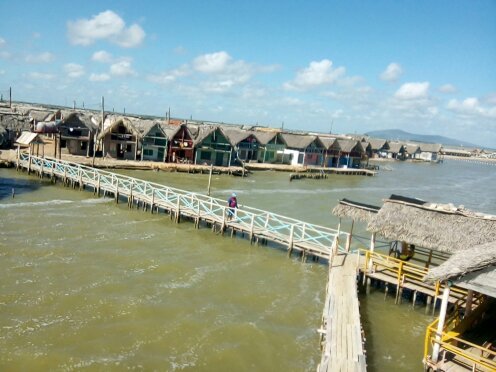
[Tomada desde mi móvil Samsung J3 Star/.Taken from my Samsung J3 Star cell phone. Una panorámica del pueblo de Playa Cunagua]
Otra característica son los materiales con los que se construyen estas modestas casas. Se usan materiales locales, como guano, y palmas, cuya madera es resistente al ambiente salino.
Los diferentes restaurantes, y algunas casas están unidas por puentes y pasillos sobre el agua. Digamos que es una especie de Venecia caribeña rústica.
Volviendo sobre la playa, se trata de una costa de muy baja profundidad, es posible caminar cientos de metros con el agua a la cintura. La costa no es erosiva, por lo tanto, no hay bancos de arena, la orilla es pedregosa, con diente de perro.
El hecho de que tenga tan baja profundidad favorece los procesos de evaporación, siendo el agua de la playa muy saturada en sales, con un sabor amargo característico.
Se puede disfrutar de un rico plato de Patao frito, que es una especie de mojarra que vive al norte de las provincias centrales, especialmente en Camagüey.
Hay una historia curiosa sobre el Patao, y es que se alimenta de algas ricas en fósforo, que pasan al organismo del animal, acumulándose en la piel y la cabeza. Normalmente, cuando se come, ciertas personas son propensas a alucinar y tener crisis de alergias que se suelen confundir con ciguatera. Lo cierto es que se trata de una fuerte intoxicación por fósforo. Así que si debutas con una de estas crisis, lo mejor es no volverlo a comer, porque el efecto es acumulativo.
Esta área tiene gran importancia para la supervivencia de las aves marinas durante sus períodos de reproducción, migración y residencia invernal. Es un sitio de reproducción de gran cantidad de ellas, que acuden regularmente año tras año a nidificar en esta zona.
Muchas aves regularmente crean sus nidos en grandes colonias, situadas en pequeñas islas, litorales aislados o cayos, mar afuera, donde están a salvo de depredadores terrestres.
La mayoría de ellas acostumbran a menudo a anidar en el mismo sitio durante años o décadas, una conducta llamada «fidelidad al sitio de cría».
Aquí les dejo algunas imágenes tomadas por mí en mi última visita. Espero las disfruten.
English Version - Click here!
Around the beach, a curious town has been built, which is generally made up of a group of modest two-story houses on stilts. The town is built at the end of a peninsula, and since the space on land is limited, it has been built on the sea. These houses were initially only used during the vacation period. But it seems that a non-negligible group of people live there permanently. Whatever the case, the town has a very busy life and it is possible to find many gastronomic offers and there is a good atmosphere in general.
Another characteristic is the materials with which these modest houses are built. Local materials are used, such as guano, and palms, whose wood is resistant to the saline environment.
The different restaurants inside the water, and some houses are linked by bridges and walkways over the water. Let's say it's a kind of rustic Caribbean Venice.
Returning to the beach, it is a very shallow coast, it is possible to walk hundreds of meters in waist-deep water. The coast is not erosive, therefore there are no sandbanks, the shore is stony, dog-toothed.
The fact that it is so shallow favors the evaporation processes, making the beach water highly saturated in salts, with a characteristic bitter taste.
You can enjoy a delicious dish of roasted Patao, which is a species of mojarra that lives north of the central provinces, especially in Camagüey.
There is a curious story about the Patao, and it is that it feeds on algae rich in phosphorus, which passes into the animal's body, accumulating in the skin and head. Normally, when eating, certain people are prone to hallucinating and having allergy attacks that are often confused with ciguatera. The truth is that it is a strong phosphorus poisoning. So if you experience one of these crises, it is best not to eat it again, because the effect is cumulative.
This area is of great importance for the survival of seabirds during their periods of reproduction, migration and winter residence. It is a breeding site for a large number of them, which come regularly year after year to nest in this area.
Many birds regularly create their nests in large colonies, located on small islands, isolated coastlines or cays, out to sea, where they are safe from terrestrial predators.
Most of them often tend to nest in the same place for years or decades, a behavior called "breeding site fidelity."
Here are some images taken by me on my last visit. I hope you enjoy them.
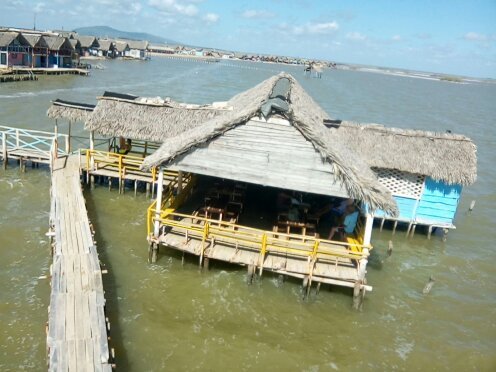
[Tomada desde mi móvil Samsung J3 Star/.Taken from my Samsung J3 Star cell phone. Uno de los varios restaurantes en el agua, donde se puede degustar de un buen plato de Patao frito]
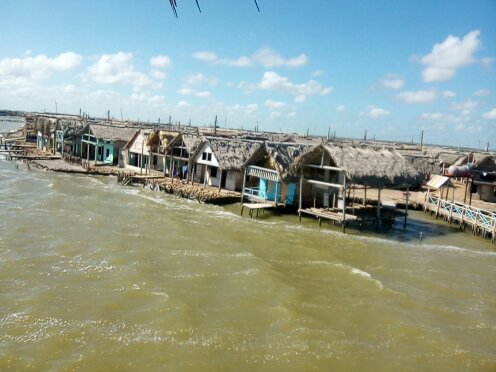
[Tomada desde mi móvil Samsung J3 Star/.Taken from my Samsung J3 Star cell phone. Otra vista del pueblo]
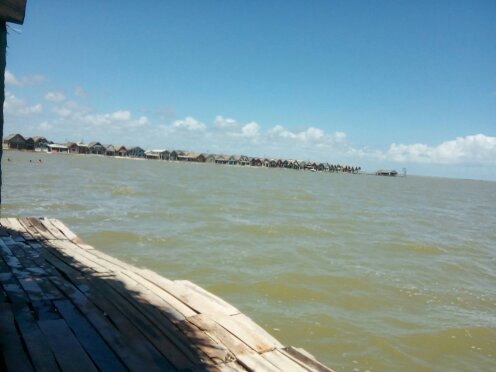
[Tomada desde mi móvil Samsung J3 Star/.Taken from my Samsung J3 Star cell phone. La playa desde uno de los muelles, al fondo se observa el pueblo]
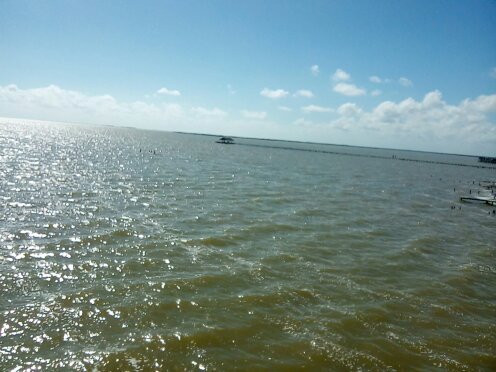
[Tomada desde mi móvil Samsung J3 Star/.Taken from my Samsung J3 Star cell phone. La poca profundidad y el pobre oleaje hacen de la playa un buen lugar para bañarse]
Hasta la próxima
English Version - Click here!
If you have come this far, all that remains for me is to thank you for reading and wish you all the good things in the world. If one day you visit the center of the Island, come to this place and be careful with the fried Patao.
Until next time
No sabía que existía esta comunidad y mucho menos esa forma de construcción, muy lindo e instructivo tu post. Gracias por compartir.
Si es realmente una maravilla. Este asentamiento es único, pero se pueden encontrar parecidos en toda la zona de la costa norte de Camagüey-Ciego. Gracias por comentar
Congratulations @lapgarcia! You have completed the following achievement on the Hive blockchain And have been rewarded with New badge(s)
Your next target is to reach 1500 upvotes.
You can view your badges on your board and compare yourself to others in the Ranking
If you no longer want to receive notifications, reply to this comment with the word
STOPCheck out our last posts: